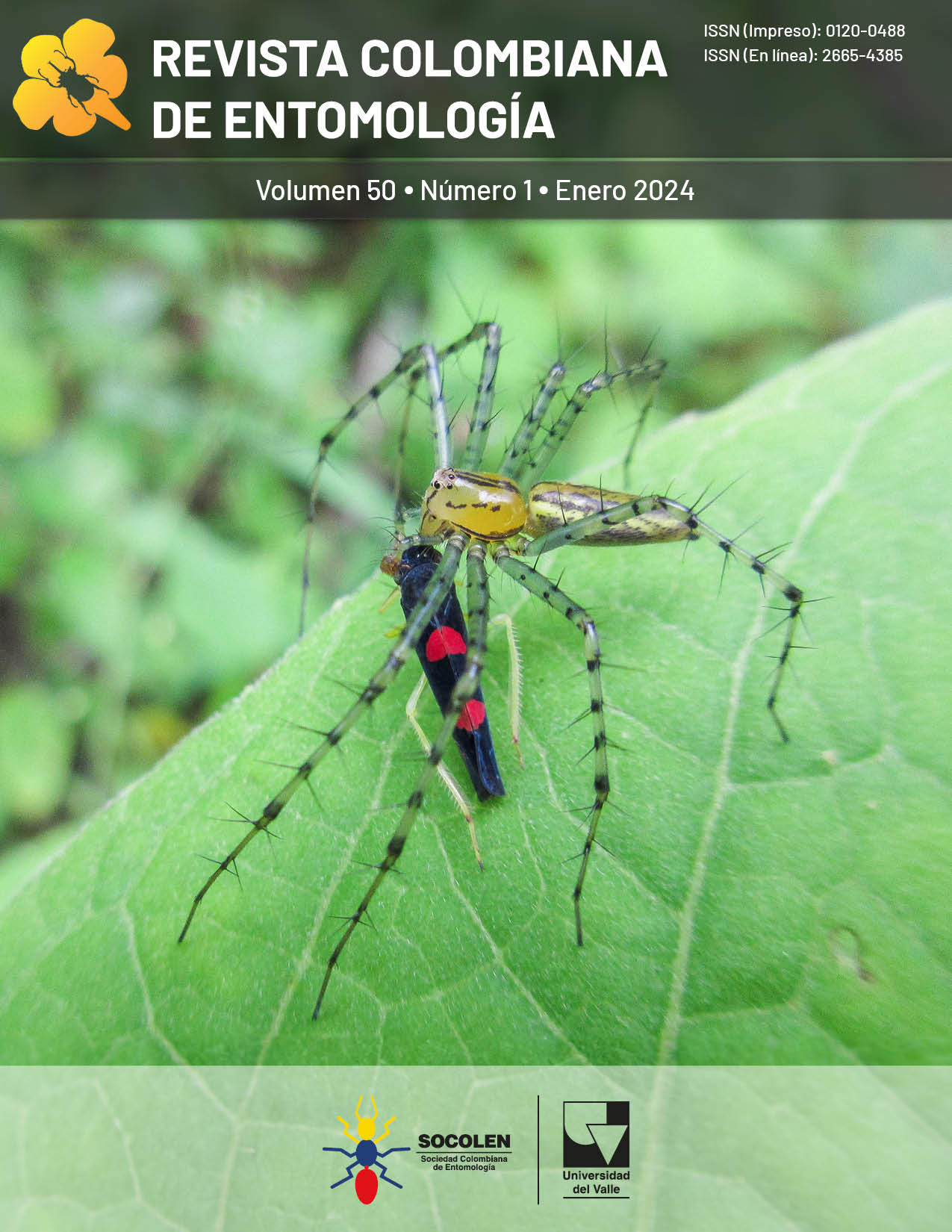First record of Caliothrips phaseoli (Hood, 1912) (Thysanoptera: Thripidae) on Arachis spp. (Fabaceae) in Brazil
Keywords:
Terebrantia, Amazon, bean thrips, legume, phytophagous insectMain Article Content
The objective of this work was to establish the first record of Caliothrips phaseoli (Hood, 1912) (Thysanoptera: Thripidae); in forage peanut accessions in the state of Acre, Brazil. The specimens were collected directly from the leaves of infested plants grown in pots and under greenhouse conditions, preserved in 70 % ethyl alcohol, and mounted on slides to later be observed under a microscope. Caliothrips phaseoli is a polyphagous species considered an important pest in bean and soybean crops in Brazil. The insect feeds on forage peanuts causes chlorosis on the leaves and delays the development of infested plants, although no mortality was verified.
Agrofit – Sistema de agrotóxicos fitossanitários. (2024). Available at: http://extranet.agricultura.gov.br/agrofit_cons/principal_agrofit_cons [Date: 10 March 2024].
Annicchiarico, P., Pecetti, L., Abdelguerfi, A., Bouzgaren, A., Carroni, A. M., Hayek, T., M’Hammadi Bouzina, M., & Mezni, M. (2011). Adaptation of landrace variety germplasm and selection strategies for lucerne in the Mediterranean basin. Field Crops Research, 120(2), 283-291. https://doi.org/10.1016/j.fcr.2010.11.003 DOI: https://doi.org/10.1016/j.fcr.2010.11.003
Assis, G. M. L. de, & Valentim, J. F. (2009). Programa de melhoramento genético do amendoim forrageiro: avaliação agronômica de acessos no Acre. Amazônia: Ciência & Desenvolvimento, 4(8), 207-215. https://www.embrapa.br/en/busca-de-publicacoes/-/publicacao/659037/programa-de-melhoramento-genetico-do-amendoim-forrageiro-avaliacao-agronomica-de-acessos-no-acre
Cavalleri, A., Linder, M. F., Mendonça Jr., M. S., Botton, M., & Mound, L. A. (2018). Os tripes do Brasil. Available at: https://www.thysanoptera.com.br/autores/lista [Date: 10 March 2024].
Fazolin, M., Marcolino, E. F., & Mataveli, M. (2011). Potencial do ataque de pragas em Arachis pintoi cv. BRS Mandobi. In: Produção de sementes de Arachis pintoi cv. BRS Mandobi no Acre. Rio Branco: Embrapa Acre (Sistema de produção, 4). Available at: < https://ainfo.cnptia.embrapa.br/digital/bitstream/doc/913652/1/24115.pdf > [Date: 10 March 2024].
Fazolin, M., Vasconcelos, G. J. N. de, Lima, E. F. B., Santos, R. S., & Azevedo, H. N. de. (2015). Reconhecimento de artrópodes de importância econômica para o amendoim forrageiro. Rio Branco: Embrapa Acre. 66 p. (Documentos, 137). https://www.embrapa.br/en/busca-de-publicacoes/-/publicacao/1032774/reconhecimento-de-artropodes-de-importancia-economica-para-o-amendoim-forrageiro
Guidoti, M., Santos, R. S., Fazolin, M., & Azevedo, H. N. de. (2014). Gargaphia paula (Heteroptera: Tingidae): First host plant record, new geographic data and distribution summary. Florida Entomologist, 97(1), 322-324. https://doi.org/10.1653/024.097.0152 DOI: https://doi.org/10.1653/024.097.0152
Jank, L., Valle, C. B., & Resende, R. M. S. (2011). Breeding tropical forages. Crop Breeding and Applied Biotechnology (n.s.), 11, 27-34. https://doi.org/10.1590/S1984-70332011000500005 DOI: https://doi.org/10.1590/S1984-70332011000500005
Lima, E. F. B., Monteiro, R. C., & Zucchi, R. A. (2013). Thrips species (Insecta: Thysanoptera) associated to Fabaceae of agricultural importance in Cerrado and Amazon-Caatinga ecotone from Brazilian Mid-North. Biota Neotropica, 13(2), 283-289. https://doi.org/10.1590/S1676-06032013000200027 DOI: https://doi.org/10.1590/S1676-06032013000200027
Lima, E. F. B., O’Donnel, C. A., & Miyasato, E. A. (2020). The Panchaetothripinae (Thysanoptera, Thripidae) of Brazil, with one new Caliothrips species. Zootaxa, 4820(2), 201-230. https://doi.org/10.11646/zootaxa.4820.2.1 DOI: https://doi.org/10.11646/zootaxa.4820.2.1
Lima, E. F. B., Alencar, A. R. S., Nanini, F., Michelotto, M. D., & Correa, A. S. (2022). “Unmasking the villain”: integrative taxonomy reveals the real identity of the key pest (Thysanoptera: Thripidae) of peanuts (Arachis hypogaea) in South America. Insects, 13(2), 120. https://doi.org/10.3390/insects13020120 DOI: https://doi.org/10.3390/insects13020120
Lima, E. F. B. (2023). Caliothrips phaseoli (Hood, 1912). Available at: http://fauna.jbrj.gov.br/fauna/listaBrasil/FichaPublicaTaxonUC/FichaPublicaTaxonUC.do?id=69594 [Date: 10 March 2024].
Monteiro, R. C., Mound, L. A., & Zucchi, R. A. (1999). Thrips (Thysanoptera) as pests of plant production in Brazil. Revista Brasileira de Entomologia, 43, 163-171. http://hdl.handle.net/102.100.100/206053?index=1
Mound, L. A., & Marullo, R. (1996). The thrips of Central and South America: an introduction (Insecta: Thysanoptera). Memoirs on Entomology International, 6, 1-487.
Rocha, R. A., & Valls, J. F. M. (2017). O gênero Arachis L. (Fabaceae) no Rio Grande do Sul. Revista Brasileira de Biociências, 15(3), 99-118. https://www.seer.ufrgs.br/index.php/rbrasbioci/article/view/114614/61920
Sá, C. P. de, Andrade, C. M. S. de, & Valentim, J. F. (2010). Análise econômica para a pecuária de corte em pastagens melhoradas no Acre. Rio Branco: Embrapa Acre. 5 p. (Circular técnica, 51). https://www.embrapa.br/en/busca-de-publicacoes/-/publicacao/859145/analise-economica-para-a-pecuaria-de-corte-em-pastagens-melhoradas-no-acre
Santos, R. S., & Lima, E. F. B. (2016). Registro de tripes (Thysanoptera: Thripidae) em hortelã (Mentha sp.) no estado do Acre. Rio Branco: Embrapa Acre. 18 p. (Boletim de Pesquisa e Desenvolvimento, 54). https://ainfo.cnptia.embrapa.br/digital/bitstream/item/148305/1/26135.pdf
Santos, R. S. (2021). Primeiros registros de tripes (Thysanoptera: Thripidae) associados ao girassol no estado do Acre. Agrotrópica, 33(3), 229-234. https://ainfo.cnptia.embrapa.br/digital/bitstream/item/230347/1/27261.pdf DOI: https://doi.org/10.21757/0103-3816.2021v33n2p229-234
Valentim, J. F. (2011). Introdução. In: Produção de sementes de Arachis pintoi cv. BRS Mandobi no Acre. Rio Branco: Embrapa Acre (Sistema de produção, 4).
Valle, C. B. do, Jank, L., & Resende, R. M. S. (2009). O melhoramento de forrageiras tropicais no Brasil. Revista Ceres, 56(4), 460-472. https://www.redalyc.org/articulo.oa?id=305226808013
Downloads

This work is licensed under a Creative Commons Attribution-NonCommercial-ShareAlike 4.0 International License.
Authors retain the copyright on their work and are responsible for the ideas expressed in them. Once a manuscript is approved for publication, authors are asked for a publication license for the term of legal protection, for all territories that allows the use, dissemination and disclosure of the same.

